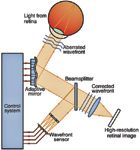Article
Adaptive optics creating a clearer view of the retina
By actively correcting for wavefront aberration in the optical path between the imaging camera and the retina, adaptive optics technology has emerged as an enabling technology for cellular-level resolution.
For vision scientists, the human retina promises to be a window into the health of a patient. A clear view of the retina in vivo with high-resolution detail of photoreceptors and vascular flow could give the vital detail that would enable clinicians to make early and accurate diagnosis of diseases.
This window is blurred, however, by imperfections in the eye itself: the cornea and crystalline lens, as well as the viscous and non-uniform nature of the vitreous humor, keep clinicians from viewing the important cellular structures. Optically, this blurring, or image distortion, is caused by tissue-induced wavefront aberration in the light that images the retina and results in a low-resolution image. By actively correcting for wavefront aberration in the optical path between the imaging camera and the retina, adaptive optics (AO) technology has emerged as an enabling technology for cellular-level resolution and extracting vital information from the human retina.
Today's optical instruments
The fundus film camera is still considered the gold standard for retinal imaging instrumentation, according to Richard Calderon, OD, FAAO, chief of the Advanced Diagnostic Imaging Center at Joslin Diabetes Center, Boston.
"Digital fundus images may have the convenience factor for e-mailing images etc., but film often offers greater resolution, especially when looking at gray scale," Dr. Calderon said.
The strengths of the scanning laser ophthalmoscope (SLO) lie in the ability to create video-rate images using a low-energy light source, whereas the main advantage afforded by optical coherence tomography (OCT) is its high axial resolution. The high-resolution images come at a cost of slow image acquisition.
"Loss in resolution is due to the long image acquisition time, which is slower than eye movement," noted Joseph Izatt, PhD, associate professor of ophthalmology and associate professor of biomedical engineering at Duke University, Durham, NC.
While clinical retinal imaging instruments are achieving ever-greater resolution capabilities, the eye itself imparts the final obstacle in ultra-high-resolution imaging. Ophthalmologists have long been interested in imaging cellular structures in the retina to examine photoreceptor properties in vivo and to characterize retinal disease more precisely. A number of vision science researchers recently have succeeded in cellular-level resolution by actively correcting light distorted by the cornea and crystalline lens.
Adaptive optics 101
The purpose of AO is to compensate for wavefront aberrations caused by a distorting medium in the optical path. AO systems are composed of three elements:

The sensor, called a Shack-Hartmann sensor, works by breaking up the incoming wavefront into a number of small pieces using an array of miniature lenses, called lenslets, which then focus the light onto the CCD array camera. Changes in wavefront result in changes in spot location on the camera-thus measuring the wavefront.
Newsletter
Don’t miss out—get Ophthalmology Times updates on the latest clinical advancements and expert interviews, straight to your inbox.




